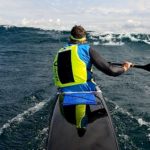Surfski Leash System – Critical Always, but Especially as We Move Into the Cold Months
While safety is always critical when paddling a surfski, as we transition into the colder months the margin for error paddling in the Great Lakes becomes razor thin.
Billy Bellinger, a good friend of mine and very experienced Lake Michigan paddler in Holland, MI devised a very simple yet effective leash system that I would like to share.
First a few words about Billy. Billy is a commercial airline pilot and safety is ingrained into his subconscious. But like many of us, he is also addicted to the rush of running his Epic V10 Sport downwind in six to eight foot swells a mile offshore on Lake Michigan. Before getting into surfski paddling Billy also did a lot of surf kayaking and has sent me pictures of paddling around ice bergs in the depths of winter. Safe to say, he has some great paddling experience in all different kinds of conditions and a relentless focus on making sure he has a bullet proof safety plan every time he goes out.
The leash system Billy devised consists of a three foot length of rope and a six foot length of rope. Both sections of rope are setup with a 1 ½ inch bowline knot loop on both ends. The rope that Billy uses is a 5 millimeter Prusik Cord, but any high strength rope that won’t unravel should work. In addition to the rope, the only other piece required is an aluminum carabiner that will clip around the shoulder strap of your PFD. (both items can be purchased at stores that sell climbing gear)
I’m not a big knot guy, and learning a bunch of slick knots has been on my to-do list for a long time. Luckily my years of commercial fishing ingrained the bowline into my subconscious and I can tie one in a split second with my eyes closed. (Lots of dark nights hanging over the front of a skiff in six foot swells tying off salmon nets in raging currents
For those who aren’t familiar with this knot, below is a diagram that should help. It is absolutely critical for this leash system that you tie this knot correctly. I have never seen one of these comes undone and they can be untied quickly and easily if needed.

The Setup:
- Once the knots are tied on both ends, take your six foot line and wrap it around your foot strap and take one end through the loop on the other end and synch tight. (Note: if you do have a leash attachment point on your ski, you can tie a permanent bowline with a couple half hitches around this. If available, it is a better option than the foot strap. )
- Next take your three foot line and thread the loop on one end through the end of the long rope. This three foot line will slide up and down the six foot line and clip into the carabiner on your PFD
- Connect the free end of the three foot line into the carabiner on your PFD shoulder strap.
- Now thread the free end of your six foot line through itself creating a synch- able loop and put it around your paddle and synch at the midway point of the paddle shaft.
- You should now be setup such that paddle is attached to the boat via the six foot line and your PFD is attached via the three foot line into the six foot line. Ultimately this setup will allow you to get up to 9 feet away from your boat while still holding together you, your paddle, and your boat.


Additional Points
- If you have a leash attachment point on your ski, I strongly recommend you tie one end of the six foot line to this, rather than wrapping it around the foot strap. Use a bowline knot with an extra half hitch or two, to ensure it never comes undone.
- I think it is highly unlikely the carabiner would ever get opened and the rope would slip out, but you can get a locking carabiner to be extra safe. I recommend a strong aluminum carabiner just to be extra safe.
The beauty of this leash system is that it keeps everything together, you, your boat, and your paddle, while the carabiner gives you an option to disconnect if needed. I know a lot of guys have been perfectly fine for a long time with just a leg or paddle leash and that is all I’ve done for the past nine years, but after trying out this system I really like it on the big wind and wave days. I have heard stories of incidents where for whatever reason the paddle gets away after a paddler comes off his boat. While this should not be a deadly situation, it can make the difference between a self-rescue and calling for help.
What I also like about having both the boat and paddle connected is that if I need both hands free to assist someone else with a rescue, call for help, get something re-adjusted, etc., I have that option. I thought at first that the rope attached to the paddle with bother me, but honestly once I start paddling I don’t even notice it is there.
I still see a place for the leg and paddle leashes, but I am convinced this is a really nice additional option to have in your quiver.
If you have any questions, post them here and Billy or I will try to get back to you.


